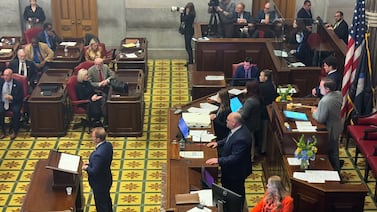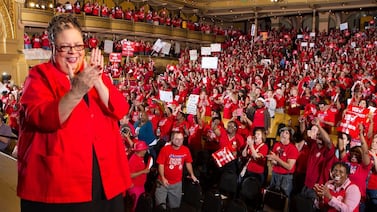Chalkbeat is a nonprofit news organization covering public education in communities across America. Subscribe to our free Colorado newsletter to keep up with education news from around the state: ckbe.at/subscribe-colorado
When Centennial Elementary in Greeley was facing state intervention in 2016, Superintendent Deirdre Pilch, who was new at the time, decided to try something different.
She surprised then-Principal Anthony Asmus by letting him decide how he wanted to turn things around at the school.
“She backed us up,” recalled Asmus. “We had the choice for this. That was big.”
Seven years later, Centennial is being cited as a success story in a new study commissioned by the state that highlights the importance of local leaders and classroom teachers taking ownership of school improvement efforts.
Officials with the Colorado Department of Education are using the findings to improve how they help schools in turnaround. The state on Wednesday approved the latest round of school improvement dollars.
The case study, presented to the State Board of Education in October, follows Centennial Elementary and Prairie Heights Middle School, two Greeley schools that joined the state’s Transformation Network and have maintained their improvements over time.
Researchers found that narrowing the focus to fewer improvement strategies, empowering teachers to lead change in their classrooms, and having good relationships between state, district, and school leaders, are key.
And, importantly, the study found, local educators such as teachers and school leaders have to feel ownership of the work that’s happening, rather than being told what to do.
“There was a need to go a little deeper on what happened to those schools that had left the program and sustained success,” said Elena Diaz-Bilello, a researcher at the University of Colorado Boulder, and author of the report. The study was done by the Center for Assessment, Design, Research and Evaluation (CADRE) at the CU Boulder School of Education.
“There’s a big part of the picture that’s always missing,” Diaz-Bilello said. “You don’t capture the richness that turnaround schools undergo when they are going through this work.”
Schools that join the network receive state or federal funding for three years as well as support from state experts in improving their school. To join, schools have to be identified as struggling either by state or by federal measures, and then apply. Schools that are struggling and looking for funding and state support have a long menu of program options to pick from, including the Transformation Network. State leaders say more schools have been joining.
This year, the governor allocated additional funds for school improvement work. For all school improvement grants, Colorado has $8.1 million in state dollars and $16.4 million from federal dollars. Some of the awards will be split over four years.
Sixteen schools will join the Transformation Network this year. Seven of them will receive $945,000 in state grants, while another nine will share $1.2 million in federal funds.
Many of the schools that take part in the Transformation Network, including the two in Greeley, receive benefits that last beyond the participation in the state program. Since it began, 97 schools have participated in the network.
According to state data, a majority of schools that completed three years in the network and started with one of the two lowest ratings – turnaround or priority improvement status – raised their marks to get off the state’s watch within three years.
Of all schools that have participated in the Transformation Network, about one in four had a low rating in 2022, the most recent year. That’s a marked improvement since almost all start with low ratings.
Researchers note that there isn’t evidence showing that top-down mandates for improvement– such as the state board’s directed orders that aim to force change — work.
Colorado is engaged in an ongoing debate about how well the school accountability system works to improve student outcomes. An audit found that it was largely working as designed, but superintendents still want to see changes. Meanwhile, the Adams 14 school district is resisting state-mandated reorganization orders.
One of the two recommendations in the report is to find a way to either make the Transformation Network an option for schools that reach year five of low performance, or to find a way to design state improvement orders with a focus on relationships and local ownership.
Current law lays out four pathways for schools with persistently low test scores: external management, converting to a charter, closure, or using the state’s innovation status to earn more autonomy from certain laws or union contracts.
Making the Transformation Network an official pathway option would require policy or law changes, something that’s not in the works. But state staff are working on incorporating the same relationship building into all of their other work.
“We see real power in that partnership and growing each other together,” said Lindsey Jaeckel, executive director of the state education department’s school and district transformation unit. “Just having time to coach and grow leaders and teacher leaders specifically — it affirms it’s really important to have a supportive staff culture.”
When there is collaboration, local leaders can take ownership of the work and “lean in more,” said Adam York, a research associate with the National Education Policy Center at the University of Colorado Boulder. He also worked on the case study.
“When the spirit of the turnaround is taken up this way by the schools, CDE are finding schools and districts are positively responding and they see a lot of improvement,” York said.
State officials also realized through the study that district-level support is often missing from rural schools where staff are limited. Rural schools are underserved in the network in general, so state officials have now been recruiting those schools to participate and finding ways to create relationships between them, so they can have that added level of support they may be missing.
What worked for the schools highlighted in the case study?
The schools highlighted were Centennial Elementary and Prairie Heights Middle School, both in Greeley, a growing working-class city a little more than an hour north of Denver. Researchers also looked at Dos Rios Elementary, which didn’t officially join the network, but where the district used many of the same supports.
Both Centennial and Prairie Heights had higher than average numbers of students from low-income families, and students whose home language wasn’t English. For example, this school year, about 45% of Centennial’s students identified as English learners, 7% identified as homeless, and more than 86% qualified for free or reduced-price meals.
Before joining the Transformation Network in 2016, the two schools had multiple years of low ratings and were facing state intervention if they didn’t improve. In the case of Prairie Heights, the school was put on a state-approved improvement plan the following year, but it was the plan pitched by the district. By 2018, the schools’ ratings improved.
Researchers who interviewed staff and spent time at the schools documented four key strategies that helped the schools improve:
- Using a state provided tool to define limited and focused areas of improvement, goals, and to measure progress toward them;
- Routine classroom observations connected to training;
- A collaborative culture where teachers have leadership roles in the improvement work;
- Alignment between the support provided at the school, district, and state level.
When Centennial joined the network, then-Principal Asmus, his assistant principal, and his district supervisor all used the grant money to attend training through the New York-based Relay Graduate School of Education.
“In turnaround status, you’re just grasping for things that will work. You just don’t get any traction,” Asmus said. “We thought let’s just focus. What is a program that helps us get clarity? And we were fortunate that our supervisor went with us.”
Asmus said that allowed him to receive coaching from his supervisor, who knew what he was trying to change. State leaders were also helpful, he said, but it was nice having someone closer.
The state recognized that the district’s support made a difference. So this year, it is rolling out a new rubric for participating schools to measure how well districts are supporting their schools. It’s part of trying to foster relationships so that school, district, and state leaders are working toward the same goals.
In the report, researchers also highlighted distributed leadership, a collaborative culture of helping each other improve and allowing teachers to take on leadership roles for various improvement strategies.
Asmus said that teacher training at his school changed. He started having teachers practice scripting and getting feedback on what they may say in class as part of each training.
“If things are not right, the leader takes the responsibility,” Asmus said. “I just owned that. I wasn’t afraid to jump in and model the instructional practice and get feedback myself.”
Asmus said that teachers seeing him open up and take feedback allowed them to be more open to it themselves.
“That continued on into the classroom where they would work and support each other, observing each other,” he said.
Researchers noticed that too.
“It becomes part of the ritual for teachers to model for each other and to have open classrooms so they can get feedback,” Diaz-Bilello said. “There was no risk in trying out new things because we can always correct ourselves.”
That’s good practice, Diaz-Bilello said, and not just for turnaround schools. Now that Asmus is an assistant superintendent overseeing 11 Greeley schools, that work is spreading to those schools as well.
At Prairie Heights Middle School, teachers told researchers that once they joined the network, they had a say in “everything.”
“We made decisions together and talked about what action steps we were going to take…we had a say on professional development and getting even more staff involved in that … we were even creating professional development for other staff!” teachers quoted in the report said.
And researchers saw that teacher participation continues today.
“The amount of energy, work and dedication it takes to move a school — I can’t stress enough how impressive it was to be in these schools,” said Diaz-Bilello. “Sometimes that piece is lost. You lose the human element of the stories. But it’s just such an important part, the way these schools have grown because they have nurtured such strong relationships.”
Correction: The original story only listed schools joining the Transformation Network using state funds. The list has been updated to include schools that are receiving federal funds.
Yesenia Robles is a reporter for Chalkbeat Colorado covering K-12 school districts and multilingual education. Contact Yesenia at yrobles@chalkbeat.org.







